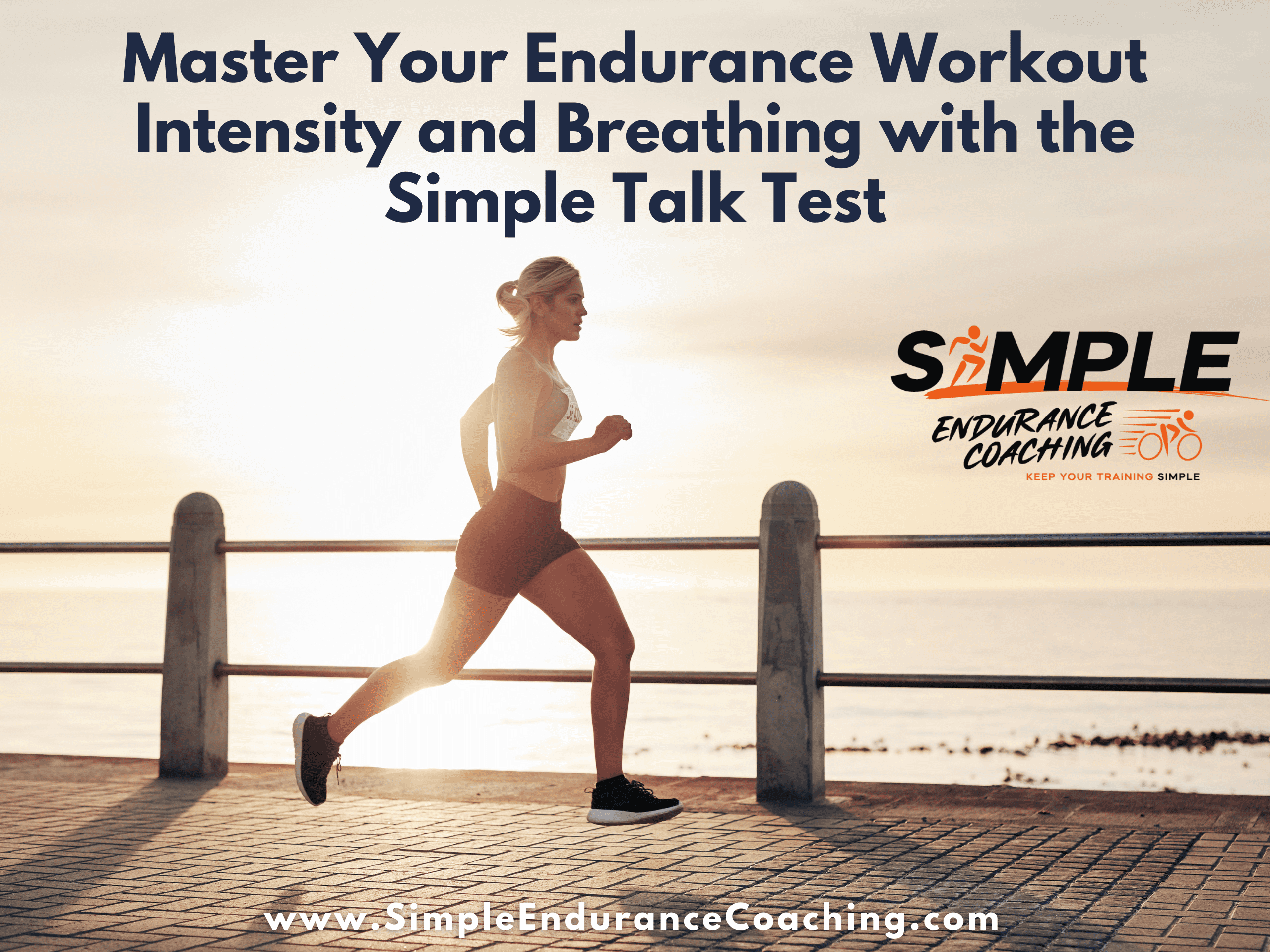Master Your Endurance Workout Intensity and Breathing with the Simple Talk Test

The Talk Test is a simple yet powerful tool for cyclists, runners, and triathletes to monitor exercise intensity and improve breathing during endurance training.
Research has shown that it’s an effective method for gauging how hard you’re working based on your ability to speak during physical activity.
Understanding the Talk Test
The Talk Test categorizes exercise intensity into four levels:
- Light Intensity (recovery):
- Description: You can carry on a conversation easily without any noticeable breathlessness.
- Perception: Feels easy; you can sing a song or talk in complete sentences comfortably.
- Moderate Intensity (endurance Zone 2):
- Description: You can speak in full sentences, but not sing. Conversation might require some effort, but you can still maintain it.
- Perception: Feels somewhat hard; you can talk but need to take breaths more frequently.
- Vigorous Intensity (working around the second threshold/LT/ Critical Power/ Critical Speed):
- Description: Speaking is possible but limited to short phrases or single words due to the need to breathe more frequently.
- Perception: Feels challenging; you are breathing hard and conversation is difficult.
- Near-Maximal or Maximal Intensity(HIIT/VO2max intensity):
- Description: Speaking is extremely difficult or impossible. You can only manage a few words at a time or none at all.
- Perception: Feels very hard to maximal effort; you are breathing very heavily and can only focus on the exercise.
Practical Application of the Talk Test
Starting an Exercise Session:
- Begin your workout and try to talk to yourself or a workout buddy. If you can hold a conversation without much effort, you are at a light intensity.
Monitoring During Exercise:
- As your workout progresses, periodically check your ability to speak. If talking becomes harder and you can only speak in short sentences or single words, you’ve moved into vigorous intensity.
Adjusting Intensity:
- Use the Talk Test to adjust your workout intensity to match your training goals. For example, if you’re aiming for moderate intensity, ensure you can talk in full sentences but not sing.
Here’s what a key study said about using the Talk Test:
“The practical lessons that can be taken from this study are as follows:
- If the ability to speak comfortably is maintained, exercise intensity is within broad HR, blood lactate, and RPE parameters for steady-state aerobic training.
- If the ability to speak comfortably is EQ (e.g., I can speak, but not entirely comfortably), then the broad HR, blood lactate, and RPE parameters for training at the MLSS or CP are likely satisfied.
- If comfortable speech is clearly absent, then the intensity of exercise is likely above the MLSS or CP and is likely in the range appropriate for “aerobic interval training.”
Benefits of the Talk Test
- Simplicity: No equipment or technology is needed.
- Accessibility: Easy for anyone to use regardless of fitness level.
- Immediate Feedback: Provides real-time monitoring of exercise intensity.
- Safety: Helps prevent overexertion, reducing the risk of injury or excessive fatigue.
Combining the Talk Test with Heart Rate Monitoring
Using the Talk Test in conjunction with a heart rate monitor can enhance your training precision.
Define Heart Rate Zones:
- Zone 1 (Very Light): 50-60% of maximum heart rate (MHR)
- Zone 2 (Light): 60-70% of MHR (corresponds to light intensity)
- Zone 3 (Moderate): 70-80% of MHR (corresponds to moderate intensity, near LT1)
- Zone 4 (Hard): 80-90% of MHR (corresponds to vigorous intensity, near LT2)
- Zone 5 (Very Hard): 90-100% of MHR (corresponds to maximal intensity)
Use the Talk Test to Correlate with Heart Rate:
- Light Intensity: You can converse comfortably (Heart Rate Zone 2).
- Moderate Intensity: You can talk in full sentences but not sing (Heart Rate Zone 3, at or slightly below LT1).
- Vigorous Intensity: Talking is limited to short phrases (Heart Rate Zone 4, near LT2).
- Maximal Intensity: Speaking is very difficult or impossible (Heart Rate Zone 5).
Adjust Training Based on Both Tools:
- Heart Rate Monitor: Provides precise numerical data to track intensity.
- Talk Test: Offers a practical, real-time check on perceived effort and breathing.
- Combined Approach: Use the talk test to confirm that your heart rate aligns with the expected intensity zone.
Benefits of Combining Both Methods
- Accuracy: Cross-referencing the talk test with heart rate data improves the accuracy of monitoring exercise intensity.
- Safety: Prevents overtraining by ensuring you’re not exceeding your intended intensity.
- Flexibility: Heart rate monitors might be less reliable in certain conditions (e.g., extreme temperatures, hydration levels), so the talk test provides a reliable backup.
- Holistic Monitoring: Integrates objective data (heart rate) with subjective perception (talk test), giving a comprehensive view of your exercise intensity.
Using the Talk Test with Power
The Talk Test can also be combined with power measurements for cyclists.Once you’ve established your Critical Power or FTP, you can use the Talk Test to make sure you’re in the right zone.
Talk Test Application:
- During rides, use the talk test to ensure you’re in the desired power zone. For instance, if you aim to stay in Zone 2, you should be able to talk in full sentences without much effort.
Adjust Intensity:
- If you find talking easier or harder than expected, adjust your power output accordingly to stay within the target zone.
Practical Benefits of Combining Talk Test with Power
- Real-Time Monitoring: Provides immediate feedback on intensity without always looking at your power meter.
- Holistic Approach: Combines perceived effort (talk test) with objective data (power meter) for more effective training.
- Adaptive Training: Helps adjust for day-to-day variations in performance due to factors like fatigue, nutrition, and stress.
Improving Breathing with the Talk Test
The Talk Test can also be a valuable tool for improving your breathing during endurance sports. Here are several ways it can help:
- Awareness and Control:
- Description: The talk test requires you to pay attention to your breathing patterns and how they change with different exercise intensities.
- Benefit: By regularly checking if you can talk comfortably, you become more aware of your breathing. This awareness helps you consciously control your breath, ensuring it stays steady and efficient.
- Improved Respiratory Muscle Endurance:
- Description: Maintaining a conversational pace during training encourages deep, rhythmic breathing.
- Benefit: This practice strengthens the respiratory muscles (diaphragm and intercostal muscles), improving their endurance and efficiency. Over time, this makes it easier to maintain controlled breathing even at higher intensities.
- Prevention of Hyperventilation:
- Description: The talk test helps you avoid pushing too hard too soon, which can lead to shallow, rapid breathing (hyperventilation).
- Benefit: By staying within an intensity where you can still talk, you encourage more effective, deeper breaths, reducing the risk of hyperventilation and promoting better oxygen exchange in the lungs.
- Stress Reduction:
- Description: The ability to converse during exercise indicates that your body is not under excessive stress.
- Benefit: Lower stress levels contribute to more relaxed and efficient breathing. This can enhance overall performance and endurance, as relaxed breathing is typically more effective and requires less energy.
- Practical Breathing Exercises:
- Description: Integrate breathing exercises that align with the talk test.
- Benefit: For example, practice diaphragmatic breathing or rhythmic breathing (e.g., 2:2 or 3:3 patterns) while maintaining a conversational pace. These exercises can improve your breathing mechanics and efficiency during actual endurance activities.
By regularly applying the talk test and focusing on your breathing patterns, you can develop more efficient breathing techniques that enhance your performance and endurance in sports.
Three Things To Know About The Talk Test:
- The Talk Test Simplifies Monitoring Exercise Intensity:
- The Talk Test is an easy and accessible method to gauge exercise intensity by checking your ability to speak during physical activity. This real-time feedback helps you adjust your workout intensity to match your training goals without the need for specialized equipment.
- Combining the Talk Test with Heart Rate and Power Monitoring Enhances Training Accuracy:
- Integrating the Talk Test with heart rate and power measurements provides a comprehensive approach to monitoring exercise intensity. This combination improves accuracy, ensures safety, and allows for adaptive training adjustments based on real-time feedback and objective data.
- The Talk Test Improves Breathing Efficiency and Endurance:
- Regular use of the Talk Test helps you become more aware of your breathing patterns and control your breath more effectively. This awareness promotes efficient breathing, strengthens respiratory muscles, prevents hyperventilation, reduces stress, and ultimately enhances overall endurance performance.
Need more?
Unlock the secrets to mastering gravel racing with my FREE 24-page Guide to Gravel Racing! Get yours here.
SIGN UP FOR A FREE Virtual Coffee so we can discuss your goals, ask questions, and talk about making your endurance training more effective, fun, and Simple.
Paul Warloski is a:
- USA Cycling Level 2 Coach
- RRCA Running Coach
- Training Peaks Level 2 Coach
- RYT-200 Yoga Instructor
- Certified Personal Trainer
Research has shown that it’s an effective method for gauging how hard you’re working based on your ability to speak during physical activity.




